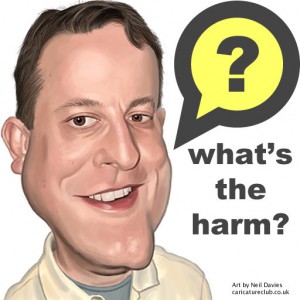As someone who doesn’t shy from telling people that pseudoscience (like homeopathy) is a load of bunk, I often get asked one terribly frustrating question over and over again:
“But, what’s the harm? Who cares if someone think astrology is real? Or if they go to an acupuncturist?”
Thanks to one person in particular, I now don’t have to spend 30 minutes telling them about how believing in one non-science is a slippery slope that leads to belief in other non-supported ideas, trying to convince them belief in pseudoscience is harmful to both individuals and society. Instead, I just point them to a website – WhatsTheHarm.net

Run by Tim Farley, WTH.net is a compilation of stories that answer that very question.
This site is designed to make a point about the danger of not thinking critically. Namely that you can easily be injured or killed by neglecting this important skill. We have collected the stories of over 670,000 people who have been injured or killed as a result of someone not thinking critically.
We do this not to make light of their plight. Quite the opposite. We want to honor their memory and learn from their stories.
 In addition to his work cataloging the harms of pseudoscience to his fellow humans, Tim is also a Research Fellow for the James Randi Educational Foundation (JREF) who specializes in electronic media. He is a prolific poster on Twitter and Facebook, and put together the information in the JREF’s Today in Skeptic History iPhone app. A computer software engineer by trade, Tim has published work in skeptical and professional outlets and has two patents.
In addition to his work cataloging the harms of pseudoscience to his fellow humans, Tim is also a Research Fellow for the James Randi Educational Foundation (JREF) who specializes in electronic media. He is a prolific poster on Twitter and Facebook, and put together the information in the JREF’s Today in Skeptic History iPhone app. A computer software engineer by trade, Tim has published work in skeptical and professional outlets and has two patents.
I had the good fortune to be able to interview Tim earlier this week, and you can find the interview transcript below. My questions are in italics, while Tim’s answers are in plain typeface. I’ve also included hyperlinks to further information (or explanations).
_________________________
I don’t think I had a Eureka moment. I was always interested in science, I started out studying astronomy and physics before I got into computers as a career. What I didn’t know at the time (college) is I had skeptics all around me.
So it was more of a general appreciation of science and reason, but not an overtly active skepticism then? Was that from an early age? Were you a childhood science fan?
 Yeah, it was science and science fiction from childhood, but I definitely had a few things I was interested in that I would be skeptical of now. I remember reading several of the key UFO books back then like “The Interrupted Journey,” and reading about the Betty and Barney Hill star map in Astronomy magazine.
Yeah, it was science and science fiction from childhood, but I definitely had a few things I was interested in that I would be skeptical of now. I remember reading several of the key UFO books back then like “The Interrupted Journey,” and reading about the Betty and Barney Hill star map in Astronomy magazine.Was it around then that you started WhatsTheHarm.net?
Yeah, that was a direct result of attending TAM 5. Especially the Sunday paper presentations, which are regular people talking about skeptic projects they have done. I went home and though, “Hey, I could do something like that.” it took me a few months to kick around some ideas, but eventually I landed on stories of harm as being something that needed more attention.
Originally the idea was to do a “Wall of Harm” and have it be a display at TAM. The idea being – this is why we are here. These are the people we are trying to help. As I collected the stories I realized, it would be a shame to assemble it all and only see it once a year, so a website was a natural. The idea of a physical display got dropped along the way, though I suppose that still could be done.
The most upsetting ones are always the children, because they were usually forced into their situation by their parents. At least with an adult you can say the person made a choice at some level. But a 9 year old child dying of untreated diabetes because of faith healing parents is just insane.
What does the future hold for WhatstheHarm.net? Any major changes coming, or just adding to the database?
I think that’s one of the biggest issues with a project of that size, especially one run on a volunteer basis – how do you keep it easily updated? Have you thought about working with other people on it, or turning it over to a group to run?
Well, my specialty is computer security, and that’s a very skeptical form. You have to look at a computer system and forget what the builders know about it, but think about it in a whole new way – the way an attacker looks at it. And then apply what you figure out to make the system better.
So do you think your skepticism drew you to that particular field in software engineering?

